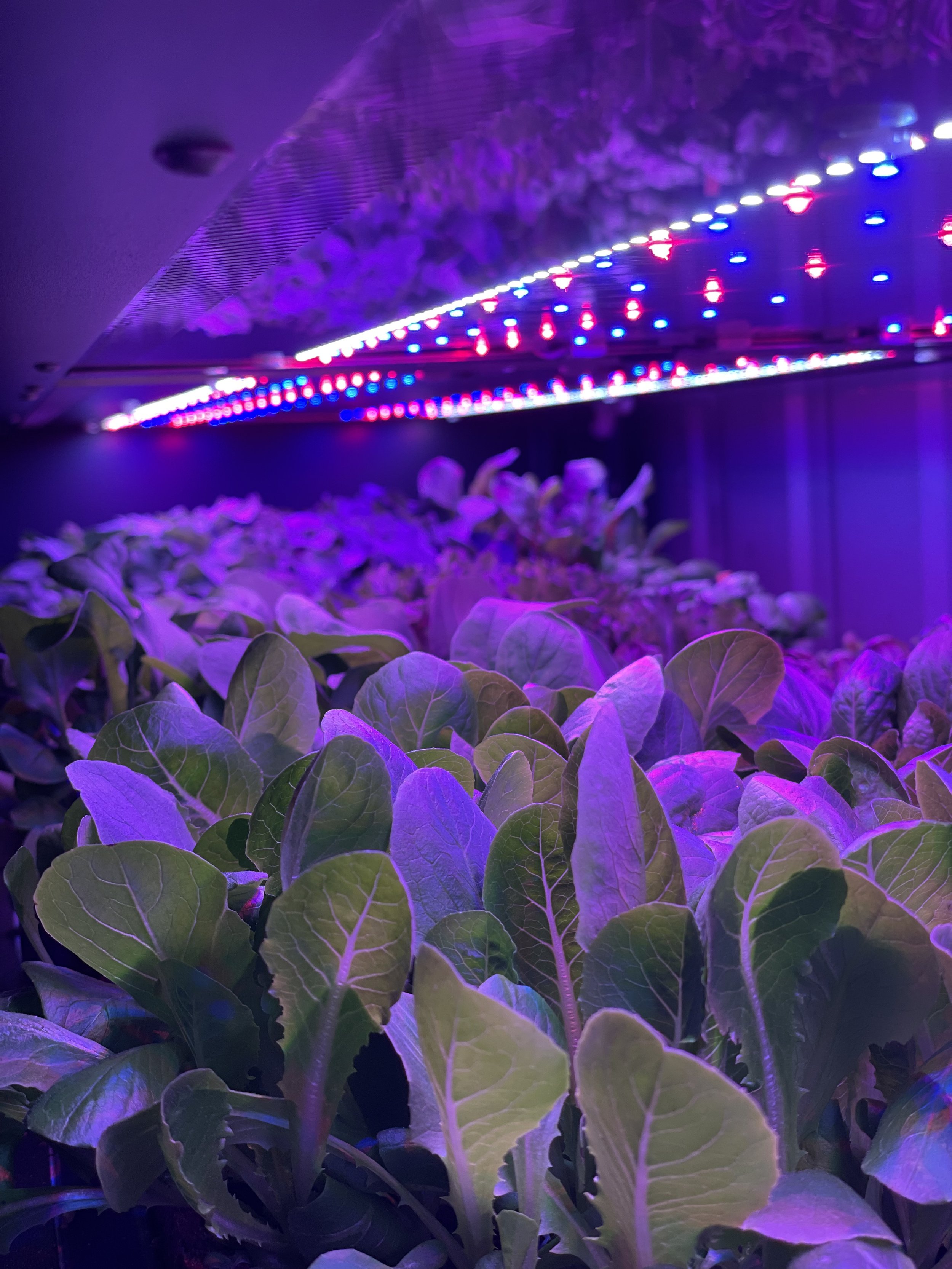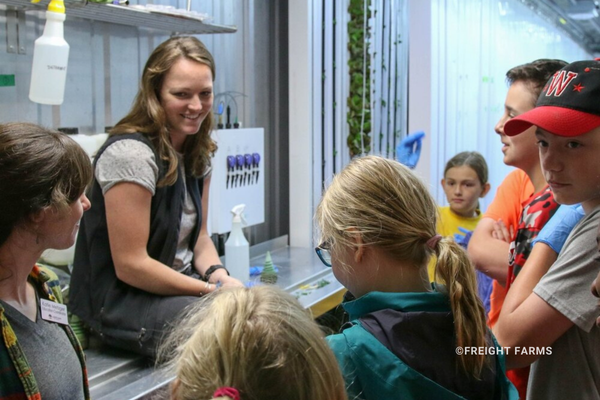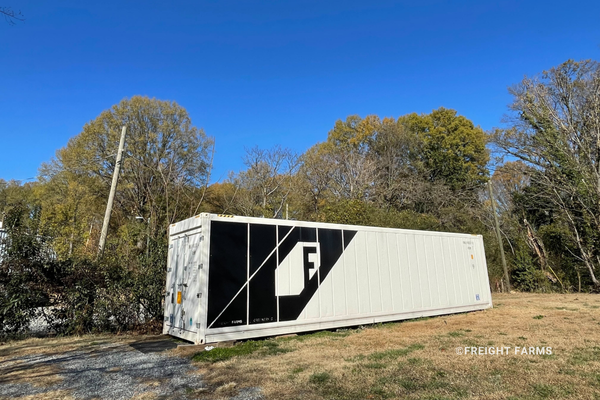
News About Farming in Shipping Containers & Limited Indoor Spaces
CANADA: Red Deer Food Bank and Church of Jesus Christ of Latter-Day Saints Partner on Hydroponic Project
Hydroponic food is growing at the Red Deer Food Bank thanks to a $75,000 grant from The Church of Jesus Christ of Latter-day Saints.
The donation allowed the food bank to purchase a hydroponic sea can, which is now growing fresh produce for the food bank’s hamper program.
“This is a big leap forward for the Red Deer Food Bank, as we can now offer a consistent supply of fresh produce to our clients,” said Mitch Thomson, food bank executive director, in a statement.
“We receive limited amounts of fresh produce from our grocery partners. Outside of harvest time, it has been extremely difficult for us to provide enough fresh produce to our clients. The development of our hydroponic food production initiatives and greenhouse allow us to be more self sufficient in providing healthy food options for our clientele.”
USA - IOWA: Tapestry Farms Receives $300k Grant From The QC Community Foundation
The Quad Cities Community Foundation is awarding Tapestry Farms a $300,000 Transformation Grant to expand their services over the next three years.
QC Community Foundation Vice President of Grantmaking and Community Initiatives Kelly Thompson says the organization is celebrating ten years of offering Transformation Grants. Unlike other grant opportunities at the foundation, this process is decided by a board committee that looks for areas of community need instead of blanket competitive applications.
"[W]e found was this intersection of welcoming refugees, helping them become long-term residents of the Quad Cities, as well as community health and nutrition," Thompson said in a phone interview with WVIK. "And Tapestry Farms welcomes refugees in part by engaging in urban farming. So they're making our Quad Cities community better, not only through helping people, but in making the land around us more sustainable, contributing to people's health and wellness by growing vegetables, all of those things."
New Mexico State University - Are Container Farms Sustainable Growing Alternatives?
Near the entrance of a 40-foot container farm installed at New Mexico State University’s Grants campus, dozens of 4-day-old kale plants lined a horizontal nursery bed, sprouting at various lengths in shades of electric green from miniature patches of densely packed soil.
Further inside, instructor Gabriel Garcia flipped a switch. Instantly, red and blue LED lights engulfed the space, illuminating the intricate vertical farming system in a shocking pink glow.
“The lights mimic the sun,” Garcia explained on a July afternoon. “This is where we’ll move the kale when their root structures develop, and they’ll stay here until they reach maturity.”
Hydroponics Provide Year-Round Growing For Alaska Farmers
Nestled between two train cars-turned-restaurants on the other side of town, Henry Krull walks inside his shipping container farm. He points to a wall that's growing hundreds of bunches of butter lettuce.
Krull is the owner of fresh365, another Kenai Peninsula based hydroponic farm. Just like Edgy Veggie, the farm operates entirely indoors.
“The advantage of growing indoors, in a container like we have, is that we can control the environment," Krull said. "We can grow no matter what’s going on outside. It can be 30 below outside, but it’s always 70 degrees or so inside.”
fresh365 also sees an uptick in direct-to-consumer sales in the winter. Otherwise, most of their sales go to other businesses, like local restaurants.
Lettuce sprouts, like these seen at Edgy Veggie in Soldotna, are placed in a specially designed watering system and grown without soil.
Texas Health's 'Growing Good Food' Initiative Funds 10 Local Organizations
The organizations benefiting from this year’s grants represent a tapestry of North Texas neighborhoods, each working on a different piece of the puzzle to make food more accessible, nutritious, and affordable for all. From urban farms to food pantries, the "Growing Good Food" awards are planting the seeds of lasting change.
One of the standout winners is Tabor Farms, based in Fort Worth. With a mission to address food inequities, Tabor Farms will use its funding to repair its vital wellhouse, which pumps water from 650 feet underground, ensuring that the urban farm can continue irrigating its crops.
USA - FLORIDA: Entrepreneurs Return To Their Roots For New Events Venue Venture
As managing partner of the Club at Renaissance in Fort Myers, Rodney Poole had been a customer of Rosy Tomorrows Heritage Farm in North Fort Myers. So when he saw the farm listed for sale, he knew it was a strong possibility for the new business venture he and his wife, Stacey, wanted to undertake.
Rodney and his partners sold the Club at Renaissance, a low-density gated development, in 2022. He and Stacey had been looking to purchase an event venue, but the couple hadn’t found the right fit yet. The farm checked a lot of boxes both in terms of uniqueness and functionality, since it already had a restaurant on-site.
Rodney looked at the property the day after he first saw the listing, bringing along chef Wesley Robbins (who’s also Stacey’s brother). “And I think from that day, we knew we were going to own it,” says Rodney.
How Shipping Containers Are Being Reimagined and Repurposed
Shipping containers may be rugged steel boxes typically used for transporting goods across the globe. But they’ve been finding new life in innovative and unexpected ways over the last couple of decades.
Beyond ports and freight yards, they’re being repurposed into functional spaces that challenge traditional architecture and design norms. From homes to shops, here’s how containers are being reimagined.
Beyond homes and shops, the adaptability of these structures has inspired a range of creative uses. Artists and architects are turning them into art studios, community centres and even urban farms.
"Fresh Lettuce Sales Thrive in Curaçao"
Curaçao enjoys year-round sunshine and consistently moderate temperatures, which might seem ideal for cultivating fruits and vegetables. However, appearances can be deceiving. Take tomatoes, for example a tomato plant requires cool night time temperatures at certain stages of growth, but in Curaçao, night time lows rarely fall below 24°C. As a result, much of the horticultural sector relies on systems that allow for partial temperature control.
Ferdinand Bouwman, who had managed a rehabilitation center on the island for years and was seeking a career change about five years ago, also opted for a controlled growing system. After experimenting with a small-scale, self-designed aquaponics setup and spending countless evenings researching vegetable cultivation online, he became intrigued by a highly controlled approach: Freight Farms. This vertical farming system, developed by a Boston-based technology company, involves growing crops in a container.
USA - New York State: Collar City Mushrooms Moving To Indian Ladder Farms
Collar City will grow its mushrooms in a shipping container, said founder Avery Stempel, which offers about as much space as the company had in Troy. As production ramps up, he said, there is room on the farm for three more containers, and Collar City’s lab and production facility will be in part of an adjacent barn.
Stempel and Ten Eyck said they expect some mushrooms may be cultivated in natural settings, but those would most likely be for demonstration purposes and perhaps a pick-your-own mushroom patch akin to Indian Ladder’s apple orchards. Stempel said the controlled environment of the shipping container and other indoor facilities is preferred for the edible mushrooms Collar City sells to markets and restaurants and other types used in products, including a skin-care line called Of the Forest that features lotions and scrubs.
NMSU Researchers Look to Container Farms as Sustainable Growing Alternatives
Near the entrance of a 40-foot container farm installed at New Mexico State University’s Grants campus, dozens of 4-day-old kale plants lined a horizontal nursery bed, sprouting at various lengths in shades of electric green from miniature patches of densely packed soil.
Further inside, instructor Gabriel Garcia flipped a switch. Instantly, red and blue LED lights engulfed the space, illuminating the intricate vertical farming system in a shocking pink glow.
“The lights mimic the sun,” Garcia explained on a July afternoon. “This is where we’ll move the kale when their root structures develop, and they’ll stay here until they reach maturity.”
The container farm was one of the first projects shepherded by NMSU’s Center of Excellence in Sustainable Food and Agricultural Systems, housed in the College of Agricultural, Consumer and Environmental Sciences.
Transforming Vertical Farming With The Greenery™
Vertical farming is revolutionizing how we grow food, offering solutions to challenges like land scarcity, water shortages, and the demand for fresh, local produce. Freight Farms' Greenery exemplifies this innovation, turning a standard 320 sq. ft. shipping container into a high-tech, efficient, and scalable farming solution.
What is vertical farming?
Vertical farming is the practice of growing crops in stacked layers, often integrated with controlled-environment agriculture (CEA). Unlike traditional farming, which requires vast horizontal land, vertical farming uses innovative techniques like hydroponics to grow plants upward. This approach minimizes land use, conserves water, and allows for year-round production in urban and rural areas alike.
Farewell to Brittany Weerts: A Year of Innovation and Growth at Purdue Student Farm
The Department of Horticulture and Landscape Architecture (HLA) bids a fond farewell to Brittany Weerts, who is concluding her tenure as Hydroponic Research Operations Administrator. Throughout her time at Purdue, Weerts has played a pivotal role in advancing the department’s controlled environment agriculture capabilities.
Petrus Langenhoven, Director of the Purdue Student Farm, reflects on Weerts’ remarkable contribution: “When I learned that a Controlled Environment Ag Facility was coming to the Purdue Student Farm, I knew we had to find someone experienced, self-driven, enthusiastic, passionate, and dedicated to managing the container farms and helping educate the next generation of growers. We were very fortunate to get Brittany Weerts to take on the role.”
Growing Minds: How Container Farms Enhance Social Emotional Learning in Schools
Hydroponic container farms provide a unique environment where students can engage in activities that promote SEL:
Unstructured Conversations: Tasks like seeding and harvesting create opportunities for meaningful dialogues between students and educators, fostering relationship skills and social awareness.
Collaborative Learning: Working together in the farm setting encourages teamwork, communication, and appreciation of diverse perspectives.
Problem-Solving: Managing farm operations requires critical thinking and responsible decision-making, skills that are transferable to various life situations.
Howdy, Indoor Farming Enthusiasts!
Welcome back to your favorite source of pre-owned hydroponic equipment information!
This month, we’re bringing you:
Two exciting listings for the opportunists amongst us
A unique case study
A tip to sell more efficiently
Why Freight Farms Makes Pesticides a Thing of the Past
Pesticides have been a cornerstone of traditional agriculture, used to protect crops from pests and diseases. But their impact on health and the environment is increasingly under scrutiny. From chemical residues in food to harmful runoff polluting waterways, the "bad" of pesticides is clear. Yet, with Freight Farms' hydroponic solutions like the Greenery™, there’s a better way to grow—without pesticides.
Vermont Organization Creates Unique Way to Garden Year-Round
Plants are growing in the cold thanks to innovative technology after one local organization created a new way of year-round sustainable farming.
How can food grow inside a shipping container?
“Food is a right for people. Nobody should be hungry. With that, while cultivating food we should be consistent of the impact that we are leaving on the environment,” said Jillian Bluestein, an intern at a new organization called Village Hydroponics.
Village Hydroponics is spearheading the effort to educate Vermont communities about how to harvest food as the climate changes while feeding Vermont families throughout the winter.
New York State - Foothills Farm Is Scaling The Production Of Hydroponic Greens For New Markets
Looking back on their first full year of production, entrepreneurs Max and Nikki Poritzky have counted one ton of produce grown and distributed to restaurants and schools from their hydroponic farming facility, Foothills Farm, in Greenfield Center.
The farm is a 40-by-eight-foot container housing an efficient, vertical growing system that produces high quality lettuces and herbs using a fraction of the space of traditional farming.
The couple have backgrounds and careers in the field of nutrition and come from health conscious families, they said.
She studied nutritional biochemistry at UC Davis and was a commercial executive marketing dietary supplements, an industry in which Max also had an executive career spanning 25 years. He said his mother founded Wild Oats, the first health food store in Saratoga Springs.
“‘Let food be thy medicine’ might sound clichéd, but this is how our families live,” Max said.
USA-MINNESOTA: Hydroponic Farm Is High Tech Operation With Small Footprint
Unlike most farmers who walk outside the door to view their crops, Tony Rahe (pronounced Ray) of Rahe of Sunshine Farms in Wykoff walks inside a door to tend to his beds of lettuce.
Instead of horizontal rows of crops planted in black soil as far as the eye can see, Rahe’s crops are planted vertically in a clean, compact space fed by constant drips of water.
Rather than being at the mercy of nature with its unpredictable weather, Rahe’s operation runs on Wi-Fi as the growing conditions are monitored by his iPad around the clock so that he has uniform light, moisture and nutrients that vary little from day to day.
How Growing Food (in a Shipping Container) Connects New American Communities in Vermont
As you drive down the hill into Burlington’s Intervale, you may notice something new: a 40-foot-long shipping container in the parking lot. It’s crimson red, with a quilt-like mural of vegetables on its side.
This is Village Hydroponics. The operation grows veggies to share, for free, with New American communities in the area.
Reporter Elodie Reed recently stopped by for a conversation with Executive Director Nour El-Naboulsi as the shipping container farm’s first season got underway.
El-Naboulsi has been a vegetable farmer for many years — though he says he’s new to hydroponics.
Gooddrop’s ‘Grow-to-Wear’ Apparel Business Looks to Mass Produce Cotton Using Vertical Farms
Currently, Gooddrop is still “two 40-foot containers of research,” says Wardle. The company also has three growing rooms for experiments, and is also growing under glass “to give us some kind of balanced data so we can understand how abundant our crop is in the controlled environment.”
The next stage for the company is to scale up, beginning with building its first R&D facility that will have roughly 1,200 square meters of growing space, says Wardle.
“It will have a spinning mill attached. It’s in the design phase. We’re drawing up the architecture at the moment, and we have a variety of different locations and types of location in the UK.”
Wardle expects Gooddrop to come to market with its first garment in 2027.





















